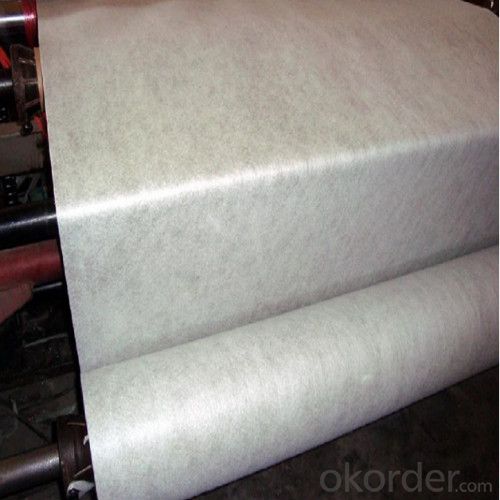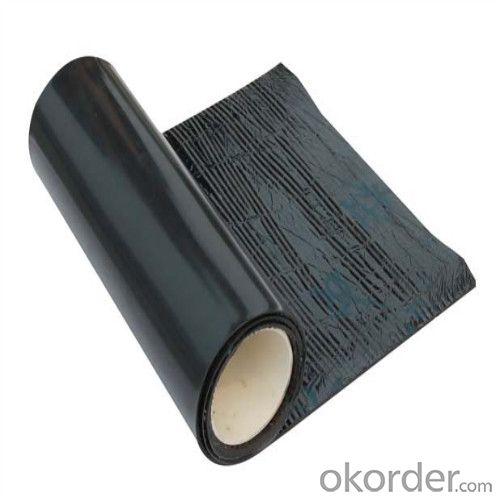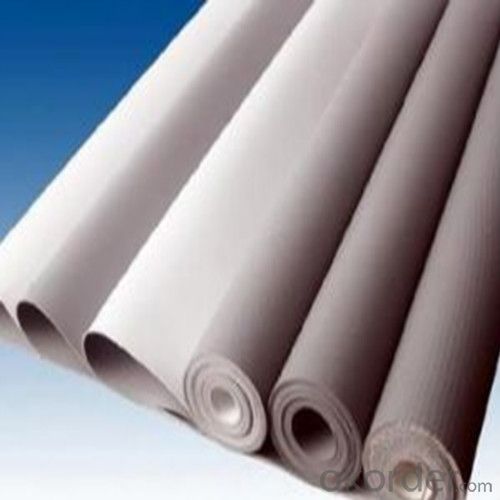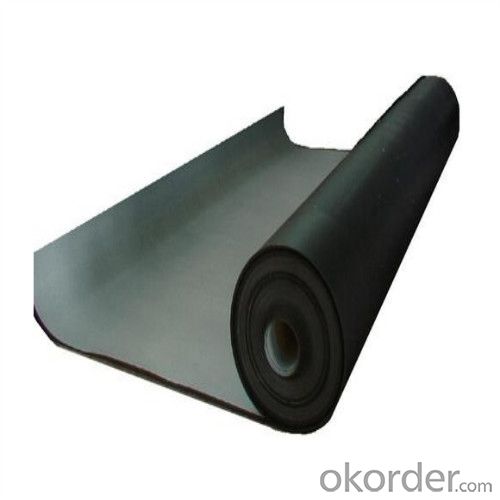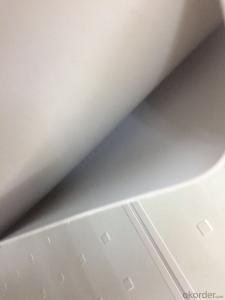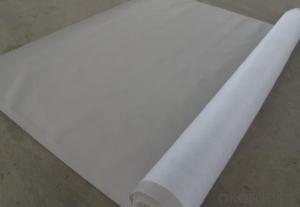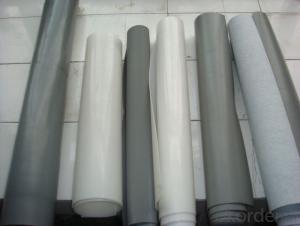Sheet Waterproof Membrane from Manufacture
- Loading Port:
- Tianjin
- Payment Terms:
- TT OR LC
- Min Order Qty:
- 1000 m²
- Supply Capability:
- 1000000 m²/month
OKorder Service Pledge
OKorder Financial Service
You Might Also Like
Sheet Waterproof Membrane from Manufacture
TPO Type and Specification
Type:
·PMT-3010 homogeneous thermoplastic polyolefin (TPO) waterproof sheet material.
·PMT-3020 Fiber backing thermoplastic polyolefin (TPO) waterproof sheet material.
·PMT-3030 reinforced thermoplastic polyolefin (TPO) waterproof sheet material.
Specification:
| Thickness of sheet material (mm) | Width of sheet material (m) | Length of sheet material (m) |
| 1.2 | 1.5,3.0 | 15,20,30 |
| 1.5 | 15,20,30 |
Advantages
·This product has perfect weather resistance,durability of EPR and the weldability of polypropylene;
·It has special technology for formula with no plasticizer which embrittles material it has high flexibility without embrittling phenomenon caused by migration of plasticizer in polyolefin , to have long time waterproof performance;
·There is an interlayer of polyester fiber fabric, offering high tensile strength, fatigue resistance, puncture resistance,which is adaptive to mechanically mounted roofing system
·Excellent low and high temperature flexibility: It is flexible even under -50℃ ,and still has mechanical strength at higher temperature;
·Chemical resistance: Resistant to erosion of acid, alkali, salt, plant oil, lubricating oil, resistant to microbial growth like algae and mould etc.
·Resistance of heat aging, good dimensional stability.
·White priority light color,smooth surface, high reflectance,better energy saving effect; Pollution resistance.
·NO chlorinated polymer or chlorine gas in ingredient,therefore no emission of chlorine during welding and other process, harmless to surroundings and humans.
·We use heatsealing to overlap, in order to form a high strength sealing layer.
Application Range
Used for all kinds of roof waterproof projects for various industrial building, civil building and public building etc.
Application Method of Construction
·PMT—3030 reinforced sheet material is adaptive to mechanically mounted waterproof system.
·PMT—3020 fiber backing sheet material is adaptive to fully bonding concrete base waterproof system.
·PMT—3010 homogeneous sheet material is adaptive to waterproof treatments for water flashing portion and for detail nodes.
CPE:
Description:
Chlorinated polyethylene waterproofing membrane are developed by our own factory, producing a new type of high-strength special waterproofing bridge, this product is based on chlorinated polyethylene-based materials, adding modifiers, anti-aging agent and promoting agents and some other enhancer complex formed by mixing two-sided rolling. With a big rally, high elasticity, oil resistance, flame resistance, weather resistance and long service life and other
comprehensive features. The product is cold construction waterproofing materials, construction, easy operation, and from climate conditions.
Application Range:
This product is suitable for all kinds of industrial and civil building roof, basement, reservoirs, ponds, sewage treatment system, civil air
defense projects, channel, girder factory waterproofing. Especially for highways, railways and culverts, bridges and other water impermeable
concrete bridge deck construction.
EPDM:
TYPE:
1. (TBD) self-adhesive rubber waterproofing membrane
Description:
EPDM (TBD) selfadhesive rubber waterproofing membrane is used (OP) rubber waterproofing membrane as based materials, Surface coating Nano-polymer adhesive glue squeeze a new high-strength self adhesive waterproofing.
Advantages:
1. High adhesive strength, durability, long after the bond;
2.Excellent weathering resistance, aging resistance;
3. Nano stabilizer added ingredients, low heat dimensional change;
4. High tensile strength, elongation, strong grass-roots stretching or cracking adaptability, resistance to low temperatures, can be adapted to -40 ℃;
5.Cold installation, easy to operate, reduce environmental pollution and improve working conditions of workers;
Application Range:
EPDM (TBD) selfadhesive waterproofing membrane used in roofing projects, exposed roofing, building foundations, basements, storage tanks, subways, tunnels, supermarkets, airports and other buildings waterproof.
2.(OP) EPDM R ubber Waterproofing membranes
Description:
EPDM (OP) Rubber Waterproofing membranes is a synthetic rubber, synthetic tire blends as the base material, adding reinforcing agents, softeners, antioxidants, curing agents processing aids to promote mixing by kneading, mixing, extrusion, rolling and curing, shaping and other processes can be processed into sheet curling volume of new high elastic waterproof material.
Application Range:
Mainly used in all types of Industrial and civil b uildings
roofing , office buildings, supermarkets, steel roofing, basements, tunnels, bridges
and other impermeable, waterproof construction .
FAQ:
1. Q: Can I get some samples?
A: We are honored to offer you samples for quality check.
2. Q: Do you have the products in stock?
A : Yes , We have sample for several models now could supply to you.
3. Q: What's the delivery time?
A: It usually takes about 25 days to produce an order. But the exact delivery time might be different for different orders or at different time.
4. Q: How does your factory do regarding quality control?
A: Quality is priority. Rock drilling tools workers always attach great importance to quality control from the every beginning to the end of the production.
Every product will be fully assembled and carefully tested before it's packed for shipment.
5. Q: Will you deliver the right goods as ordered? How can I trust you?
A: Yes, we will. Our company is world top 500, that is the biggest supplier and manufacture in China, having a good reputation around the world.
- Q: The difference between high polymer modified asphalt waterproofing membrane and sbs
- SBS modified asphalt waterproofing membrane is a kind of polymer modified asphalt waterproofing membrane, which is included with the included relationship.
- Q: Can a waterproofing membrane be used for a school?
- Yes, a waterproofing membrane can be used for a school. Waterproofing membranes are commonly used in various construction projects, including schools, to protect the building and its occupants from water damage. These membranes are typically applied to areas such as basements, roofs, and foundation walls to prevent water infiltration. By creating a barrier against moisture, a waterproofing membrane helps to maintain a dry and safe environment within the school, protecting against potential structural damage, mold growth, and other water-related issues. Additionally, waterproofing membranes often come with additional benefits such as insulation and soundproofing, which can contribute to a comfortable and conducive learning environment for students and staff.
- Q: Can a waterproofing membrane be applied to existing structures?
- Yes, a waterproofing membrane can be applied to existing structures. The application of a waterproofing membrane is a common and effective method used to prevent water infiltration and damage to buildings. Whether it is a concrete structure, a roof, or a basement, waterproofing membranes can be installed on the exterior or interior surfaces to create a barrier against water penetration. There are different types of waterproofing membranes available, such as liquid-applied membranes, sheet membranes, and spray-applied membranes, which can be chosen based on the specific requirements of the structure. The process of applying a waterproofing membrane to an existing structure typically involves thorough surface preparation, including cleaning, repairing any existing cracks or damages, and ensuring a smooth and even surface. Once the surface is prepared, the membrane is applied using the recommended method, ensuring proper adhesion and coverage. Waterproofing membranes are designed to withstand environmental factors, such as UV rays, temperature fluctuations, and water pressure, providing long-lasting protection to existing structures. However, it is important to consult with a professional waterproofing contractor to assess the condition of the structure and determine the most appropriate and effective waterproofing solution.
- Q: Can a waterproofing membrane be used for a tunnel lining?
- Yes, a waterproofing membrane can be used for a tunnel lining.
- Q: Can a waterproofing membrane be used for underground utility tunnels?
- Underground utility tunnels can benefit greatly from the use of a waterproofing membrane. This membrane, a thin layer of material, is applied to the surface of structures to prevent water or moisture from entering. It is commonly used in construction to safeguard buildings and structures from water damage. In the case of underground utility tunnels, where the risk of water infiltration is high due to surrounding soil and groundwater, a waterproofing membrane is extremely advantageous. It acts as a reliable barrier, effectively blocking water from entering the tunnel and causing harm to the utilities inside. There are various types of waterproofing membranes available, such as sheet membranes, liquid membranes, and spray-applied membranes. These membranes are typically made from materials like asphalt, modified bitumen, polyurethane, or rubberized asphalt. They are designed to be durable, flexible, and resistant to water and other environmental factors. Proper surface preparation is essential before applying a waterproofing membrane to an underground utility tunnel. The surface should be thoroughly cleaned, free of debris, and in good condition. Following the manufacturer's instructions, the membrane should then be installed, ensuring that all seams and joints are adequately sealed to create an uninterrupted water-resistant barrier. It's important to note that waterproofing membranes alone are not sufficient for protecting underground utility tunnels. They should be used in conjunction with other waterproofing measures, such as proper drainage systems, to ensure comprehensive water protection. Regular inspection and maintenance of the membrane are also necessary to promptly address any damage or deterioration. In conclusion, a waterproofing membrane is an effective solution for safeguarding underground utility tunnels against water infiltration. By establishing a strong and durable barrier against moisture, it helps maintain the integrity of utilities and prolong the lifespan of tunnel infrastructure.
- Q: Are there any specific maintenance requirements for a waterproofing membrane?
- Yes, there are specific maintenance requirements for a waterproofing membrane. Regular inspections should be conducted to check for any signs of damage or deterioration, such as cracks or leaks. Any debris or standing water should be promptly removed to prevent potential damage. Additionally, it is important to follow the manufacturer's guidelines for cleaning and maintenance, which may include periodic cleaning with mild detergents and avoiding the use of harsh chemicals or abrasive cleaning tools.
- Q: Can a waterproofing membrane be used on roofs?
- Yes, a waterproofing membrane can be used on roofs. Waterproofing membranes are commonly used on flat or low-slope roofs to provide an additional layer of protection against water infiltration. These membranes are typically made from synthetic materials such as modified bitumen, EPDM (ethylene propylene diene monomer), PVC (polyvinyl chloride), or TPO (thermoplastic olefin). They are designed to be durable, flexible, and resistant to UV rays, weathering, and ponding water. When properly installed, a waterproofing membrane can effectively prevent water from seeping into the underlying roof structure, protecting the building from leaks and water damage.
- Q: Can a waterproofing membrane be used for bridges and overpasses?
- Yes, a waterproofing membrane can be used for bridges and overpasses. Waterproofing membranes are commonly used in the construction industry to protect structures from water infiltration, including bridges and overpasses. These membranes are designed to create a barrier between the structure and moisture, preventing water from seeping into the concrete or steel components. By installing a waterproofing membrane, the lifespan of a bridge or overpass can be significantly extended, as it helps to prevent corrosion, concrete degradation, and other damages caused by water exposure. Additionally, waterproofing membranes can also provide protection against other environmental factors such as freeze-thaw cycles, chemicals, and UV radiation. Therefore, using a waterproofing membrane for bridges and overpasses is a common practice to enhance their durability and longevity.
- Q: Does a waterproofing membrane require any curing time before it can be exposed to water?
- Yes, a waterproofing membrane generally requires a curing time before it can be exposed to water. The specific curing time may vary depending on the product and manufacturer's instructions. It is important to allow the membrane sufficient time to cure and bond properly to ensure its effectiveness in preventing water penetration.
- Q: Can a waterproofing membrane be used for railways or train stations?
- Yes, a waterproofing membrane can definitely be used for railways or train stations. Waterproofing membranes are commonly used in various construction projects to protect structures from water damage and ensure their longevity. In the case of railways and train stations, where there is constant exposure to weather elements and potential water infiltration, a waterproofing membrane can play a crucial role in preventing water ingress into the infrastructure. Waterproofing membranes are typically applied to different areas of the railway or train station, such as the underground tunnels, platforms, parking areas, and even the roofs. These membranes are designed to create a barrier against water and moisture, preventing them from seeping into the structure and causing damage. By preventing water infiltration, a waterproofing membrane helps to maintain the structural integrity of the railway or train station and extend its lifespan. In addition to protecting against water, waterproofing membranes also provide other benefits such as preventing the growth of mold and mildew, improving energy efficiency by reducing heat loss, and enhancing the overall durability of the structure. They are available in various types, including liquid-applied membranes, sheet membranes, and cementitious coatings, allowing for versatile application depending on the specific needs and requirements of the railway or train station project. Overall, the use of a waterproofing membrane in railways and train stations is highly recommended to ensure the long-term performance and maintenance of these critical infrastructures.
Send your message to us
Sheet Waterproof Membrane from Manufacture
- Loading Port:
- Tianjin
- Payment Terms:
- TT OR LC
- Min Order Qty:
- 1000 m²
- Supply Capability:
- 1000000 m²/month
OKorder Service Pledge
OKorder Financial Service
Similar products
Hot products
Hot Searches
Related keywords







